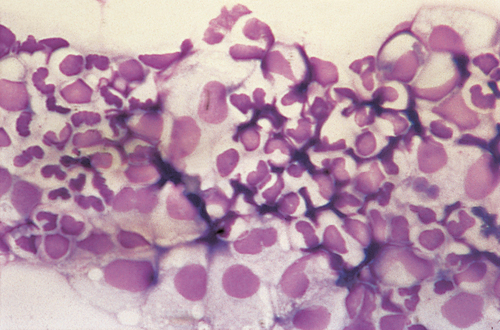Difference between revisions of "Cytology Q&A 15"
Ggaitskell (talk | contribs) (Created page with "{{Template:Manson}} [[Image:|centre|500px]] <br /> '''A three-year-old gelding was box walking, sweating, stamping and head pressing. A sample of peritoneal fluid was collect...") |
|||
| (3 intermediate revisions by 2 users not shown) | |||
| Line 1: | Line 1: | ||
| − | {{Template:Manson}} | + | {{Template:Manson |
| + | |book = Cytology Q&A}} | ||
| − | [[Image:|centre|500px]] | + | [[Image:Cytology 15.jpg|centre|500px]] |
<br /> | <br /> | ||
| Line 14: | Line 15: | ||
|a1= | |a1= | ||
The elevated TP and NCC indicate an exudate. | The elevated TP and NCC indicate an exudate. | ||
| − | |l1= | + | |l1=Colic - Peritoneal Fluid Analysis |
|q2=What cells are present ? | |q2=What cells are present ? | ||
|a2= | |a2= | ||
The cells present are neutrophils (some immature) and macrophages.<br><br> | The cells present are neutrophils (some immature) and macrophages.<br><br> | ||
Although processed immediately, stain take up is very poor and, along with the physical parameters, this suggests an abdominal catastrophe such as intestinal torsion; however, microorganisms and plant material, which would indicate rupture of an intestinal viscus, are absent. | Although processed immediately, stain take up is very poor and, along with the physical parameters, this suggests an abdominal catastrophe such as intestinal torsion; however, microorganisms and plant material, which would indicate rupture of an intestinal viscus, are absent. | ||
| − | |l2= | + | |l2=Colic - Peritoneal Fluid Analysis |
|q3=What is your diagnosis? | |q3=What is your diagnosis? | ||
|a3=Peritonitis/possible torsion. Torsion was found on laparotomy. <br><br> | |a3=Peritonitis/possible torsion. Torsion was found on laparotomy. <br><br> | ||
Note: Reference values for NCCs and classification of effusions in large animals differ from those for small animal specimens. | Note: Reference values for NCCs and classification of effusions in large animals differ from those for small animal specimens. | ||
| − | |l3= | + | |l3=Peritonitis |
</FlashCard> | </FlashCard> | ||
| + | {{#tag:imagemap|Image:Next Question.png{{!}}center{{!}}200px | ||
| + | rect 0 0 860 850 [[Cytology Q&A 16|Cytology Q&A 16]] | ||
| + | desc none}} | ||
[[Category:Cytology Q&A]] | [[Category:Cytology Q&A]] | ||
Latest revision as of 16:01, 23 September 2011
| This question was provided by Manson Publishing as part of the OVAL Project. See more Cytology Q&A. |
A three-year-old gelding was box walking, sweating, stamping and head pressing. A sample of peritoneal fluid was collected and examined immediately. It was turbid and serosanguineous, and had an NCC of 21 × 109/l and a TP of 43 g/l. Cells seen in a cytospin preparation of the fluid are shown (Wright–Giemsa, ×100 oil).
| Question | Answer | Article | |
| What type of fluid is present (fluid classification)? | The elevated TP and NCC indicate an exudate. |
Link to Article | |
| What cells are present ? | The cells present are neutrophils (some immature) and macrophages. |
Link to Article | |
| What is your diagnosis? | Peritonitis/possible torsion. Torsion was found on laparotomy. Note: Reference values for NCCs and classification of effusions in large animals differ from those for small animal specimens. |
Link to Article | |
